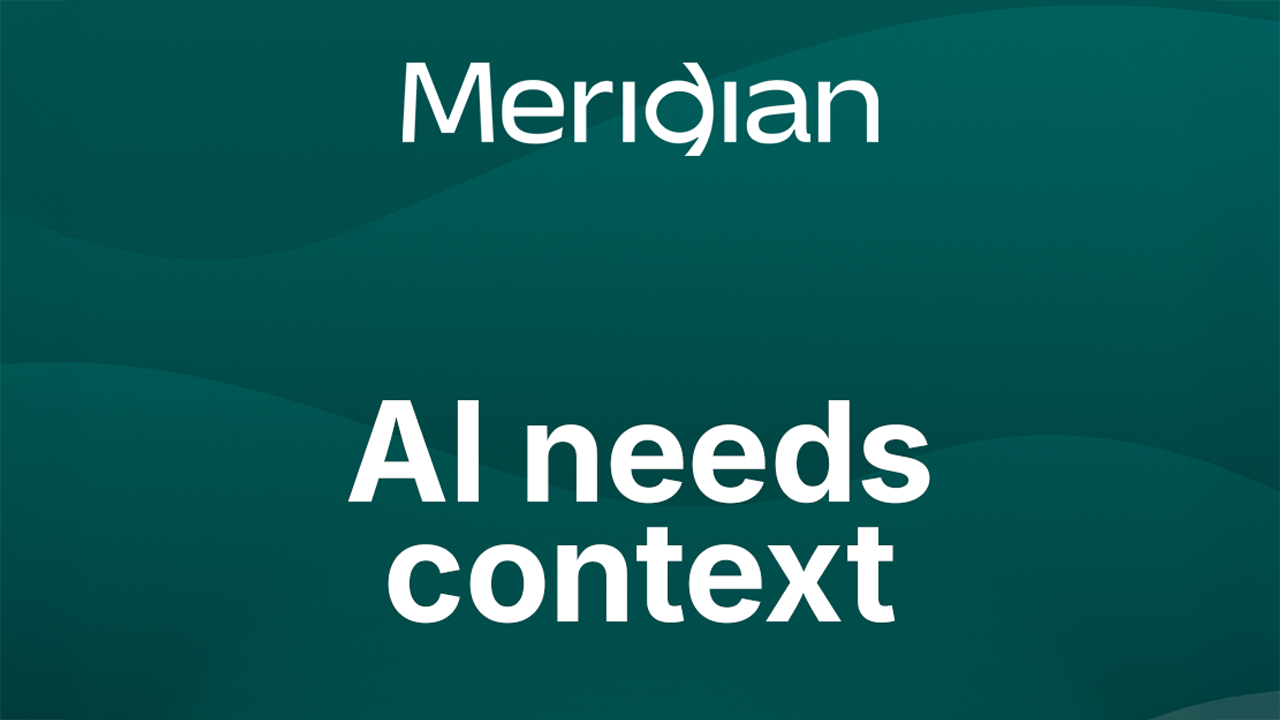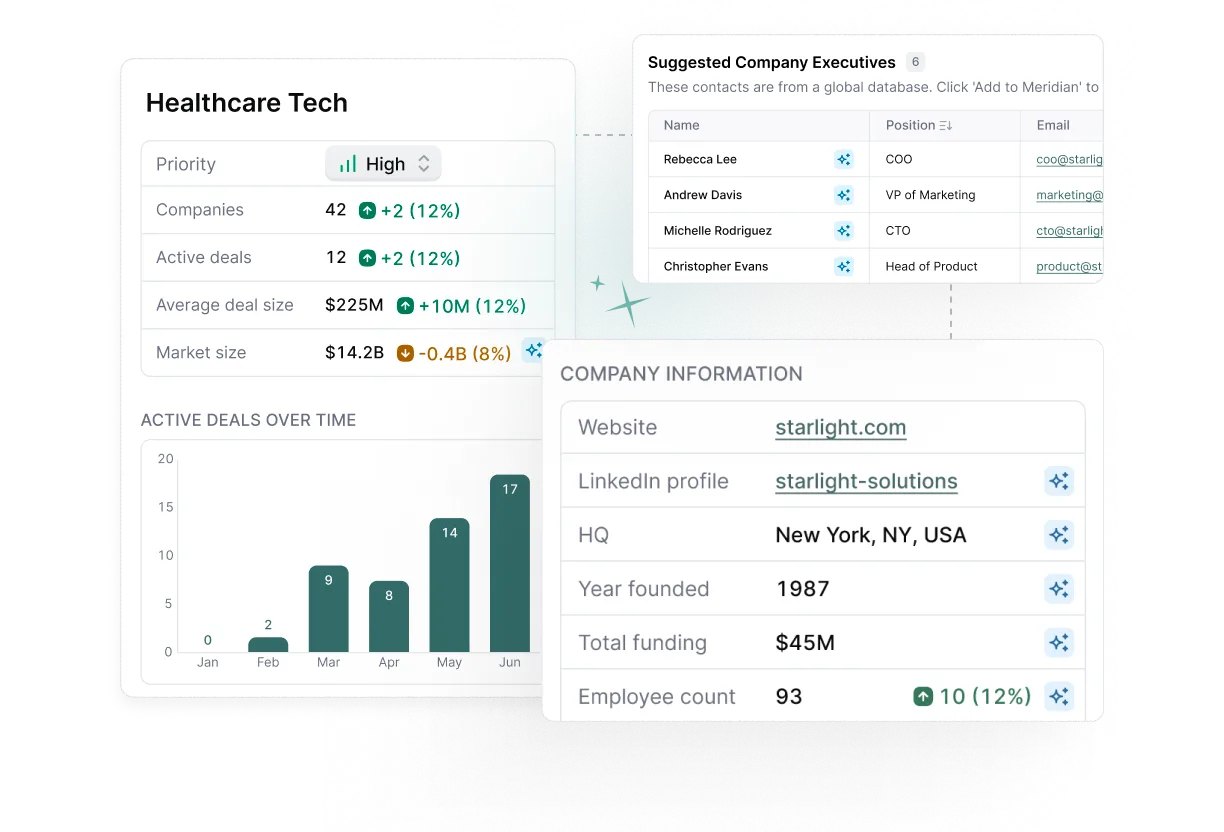Meridian raises $7M seed round led by 645 Ventures.
Read More
Learn why dumping deal data into LLMs produces nonsense and how structured context transforms AI from a liability into private equity's most powerful tool.

The promise was irresistible: take your entire deal drive, feed it to an AI model, and watch as instant insights emerge. Private equity firms across the industry have run this same experiment, expecting Large Language Models to transform their mountains of data into strategic gold. The reality? Most get back beautifully written nonsense that sounds plausible but crumbles under scrutiny.
After watching dozens of firms struggle with this challenge and building Meridian to solve it, I've learned a fundamental truth: AI without context isn't intelligence—it's just sophisticated pattern matching on incomplete information. The difference between AI that wastes your time and AI that transforms your workflow comes down to one thing: structured context.
Picture this scenario: A mid-market PE firm has just completed initial diligence on a potential acquisition. They have 10,000 documents spread across folders—financial models, management presentations, customer contracts, technical due diligence reports, legal documents. The partner thinks, "We have GPT-4 now. Let's see what it can find."
They upload everything to a generic LLM interface and ask: "What are the key risks in this deal?"
The AI responds confidently with a three-page analysis. It sounds sophisticated. It uses the right terminology. It even references specific documents. But when the associate starts verifying the claims, they discover the AI has conflated information from different time periods, mixed up data from various scenarios, and completely missed critical context about why certain decisions were made.
According to research from Stanford's Human-Centered AI Institute, LLMs without proper context achieve only 42% accuracy on complex business analysis tasks—worse than a coin flip for critical investment decisions.
When we dump raw data into an AI model, we're asking it to perform magic without giving it the spell book. Here's what typically gets lost:
Temporal Context: That EBITDA projection from 2019 isn't comparable to the 2024 forecast without understanding the business transformation that happened in between. Generic AI doesn't know that the company pivoted its business model in 2021 unless you explicitly structure that information.
Relationship Mapping: Who shared this information matters enormously in PE. A revenue projection from the selling CFO carries different weight than one from an independent quality of earnings provider. AI needs to understand these source relationships to properly weight information.
Deal Stage Awareness: A preliminary indication of interest contains aspirational projections. A final bid model contains negotiated realities. Without understanding where each document fits in the deal timeline, AI treats all information as equally valid, creating analytical chaos.
Team Dynamics: When the operating partner flags a technology risk but the deal partner pushes forward, that tension contains crucial information. Generic AI can't read between the lines of email threads and meeting notes to understand these dynamics without structured context.
Board-Level Intelligence: What management presents to the board often differs from what they share in the data room. These discrepancies aren't errors—they're insights into how the company really operates. But AI needs structured access to both sets of information to identify these patterns.

The temptation in Silicon Valley is always to start with the AI model. It's sexy. It's what gets headlines. But in private equity, where a single misunderstood data point can mean millions in losses, the boring work of structuring information is what makes AI actually useful.
Think of it like building a house. You don't start with the smart home automation—you start with the foundation and framing. In AI terms, this means:
1. Information Architecture FirstBefore any model touches your data, you need a systematic way to capture and categorize information. This isn't just folder structures—it's understanding the relationships between data points, the credibility of sources, and the context of creation.
2. Metadata That MattersEvery document needs context tags that AI can understand: deal stage, source credibility, temporal relevance, related entities, and verification status. This metadata becomes the scaffolding that AI uses to build coherent analysis.
3. Relationship GraphsPE is a relationship business, and AI needs to understand these connections. Who introduced this deal? Which advisor provided this analysis? What other deals has this management team been involved in? These connections transform isolated data points into meaningful patterns.
Meridian is your team’s ultimate context provider, driving better deals while minimizing manual data entry.

When building Meridian, we made a deliberate choice that seemed counterintuitive: we spent 80% of our development time on the boring stuff—data structure, metadata frameworks, relationship mapping—before touching any AI models.
Here's what that foundation enables:
Automatic Context Capture: Meridian doesn't just store your emails—it understands who sent them, when in the deal process, and how they relate to other communications. When AI analyzes deal risk, it knows whether that concern came from a junior analyst or the senior partner who's seen 100 similar deals.
CIM Intelligence: Every Confidential Information Memorandum gets parsed not just for numbers, but for context. Meridian understands which projections are management's base case versus upside scenarios. It knows which comparable transactions are actually comparable based on timing, size, and structure.
Board Deck Analysis: When Meridian ingests board presentations, it doesn't just extract text. It maps the evolution of key metrics over time, identifies changes in narrative, and flags discrepancies with other data sources—all because the structure allows it to understand temporal and source relationships.
Dynamic Tagging: As new information enters the system, Meridian automatically tags and relates it to existing data. This isn't simple keyword matching—it's contextual understanding based on deal stage, team involvement, and information genealogy.

When AI has proper context, the benefits compound across the entire investment lifecycle:
Due Diligence Acceleration: Instead of associates spending 60% of their time verifying AI outputs, they can trust the analysis because it's grounded in structured context. McKinsey found that PE firms using context-aware AI reduce due diligence time by 40% while improving accuracy.
Pattern Recognition Across Deals: With structured historical data, AI can identify patterns humans miss. Which red flags in previous deals led to value destruction? What management characteristics correlate with successful exits? Context makes these insights possible.
Knowledge Transfer: When senior partners retire, their pattern recognition usually walks out the door. Context-aware AI captures not just their deals, but their decision-making patterns, preserving institutional knowledge.
Real-Time Intelligence: During live deals, context-aware AI can instantly surface relevant information from past transactions. Not just similar companies, but similar situations, team dynamics, and market conditions.
Building context-aware AI isn't just a technical challenge—it's an organizational one. Here's what PE firms need to consider:
Data Discipline: Context-aware AI requires consistent data input practices. This means standardizing how teams capture information, not just storing it. It's a change management challenge as much as a technology one.
Privacy and Security: Structured context makes data more valuable but also more sensitive. Firms need robust security frameworks that protect information while enabling AI analysis.
Model Training: Generic LLMs need significant fine-tuning to understand PE-specific contexts. This isn't a one-time effort—models need continuous training as market dynamics and deal structures evolve.
Integration Complexity: Context comes from multiple systems—email, CRM, deal rooms, portfolio monitoring tools. True context-aware AI requires integration across all these platforms.

The real test of context-aware AI isn't whether it can write impressive memos—it's whether it improves investment outcomes. Key metrics include:
Early adopters of context-aware AI in PE are seeing 30% reductions in time to initial investment decision, 50% fewer hours spent on information verification, and 25% improvement in post-investment value creation planning accuracy.
The allure of dropping everything into an AI and getting instant insights will always be tempting. But in private equity, where decisions involve hundreds of millions of dollars and affect thousands of jobs, we need AI that we can trust. That trust comes from context.
The firms that will win with AI aren't the ones with access to the most powerful models—those are becoming commoditized. The winners will be those who invest in the boring, foundational work of structuring their information before asking AI to analyze it.
This isn't about constraining AI's capabilities—it's about channeling them effectively. When AI understands not just what information exists, but why it exists, who created it, when it was relevant, and how it connects to everything else, that's when the magic actually happens.
The future of AI in private equity isn't about replacing human judgment. It's about augmenting it with context-aware intelligence that turns overwhelming data into actionable insights. But that future requires us to do the boring work first: building the structure that makes intelligence possible.
Discover how Meridian can streamline deal sourcing and enhance your decision-making

Table of Contents


Learn how to build a repeatable sector research program that helps your firm surface targets earlier, improves outreach, and speeds IC decisions.

